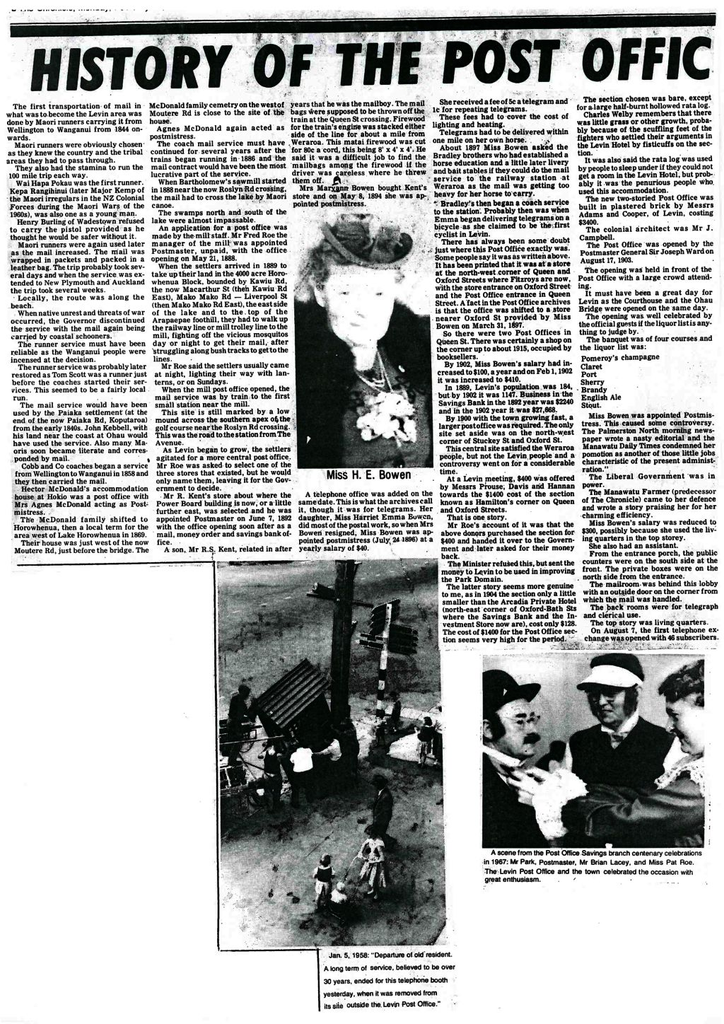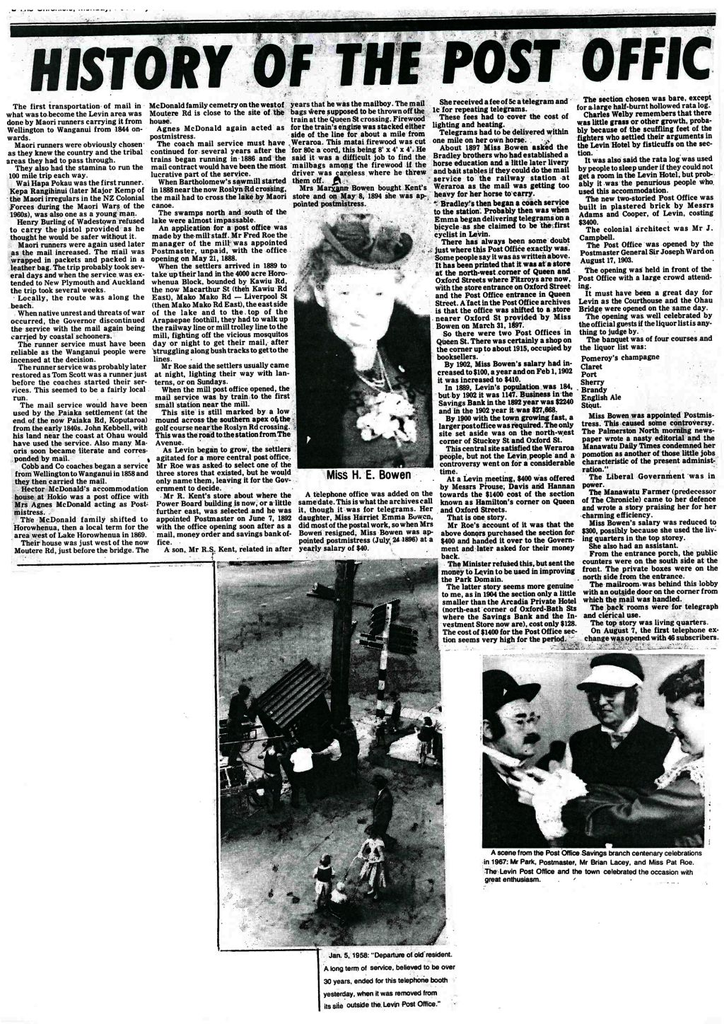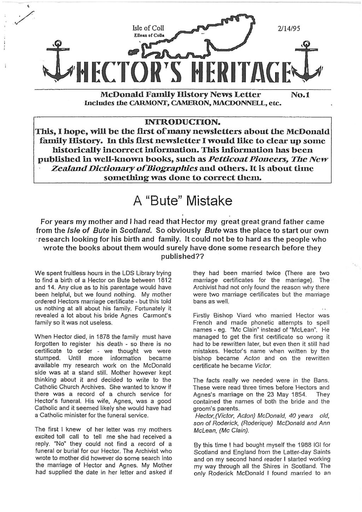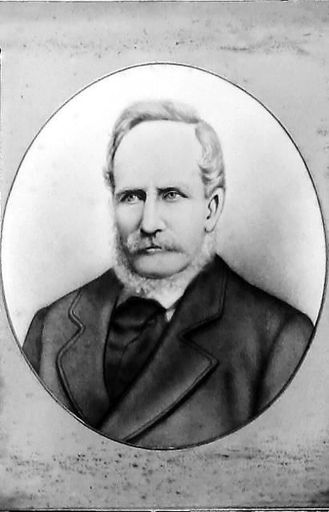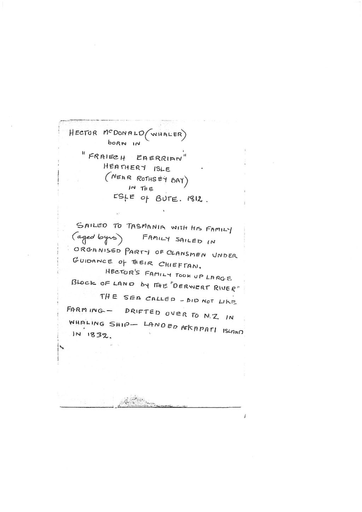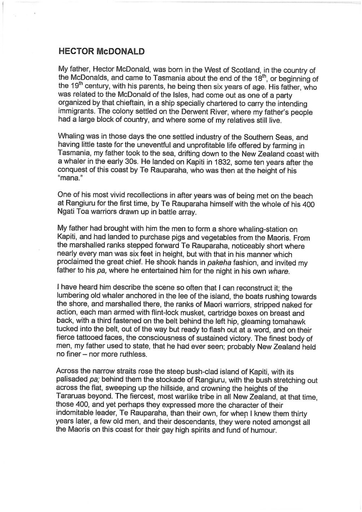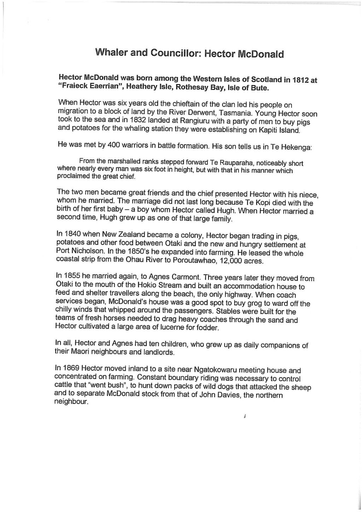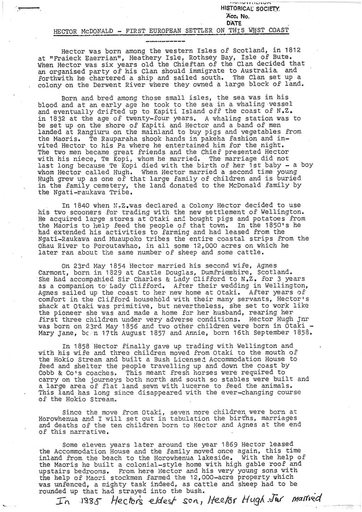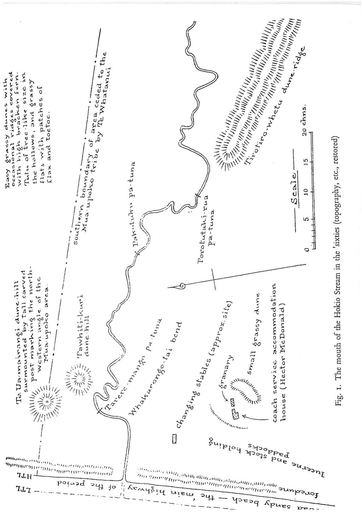History of The Post Office In Levin
- Description
Maori runners were obviously chosen as they knew the country and the tribal areas they had to pass through. They also had the stamina to run the 100 mile trip each way.
Wai Hapa Pokau was the first runner, Kepa Rangihinui (later Major Kemp of the Maori irregulars in the NZ Colonial Forces during the Maori Wars of the 1860s), was also one as a young man.
Henry Burling of Wadestown refused to carry the pistol provided as he thought he would be safer without it.
Maori runners were again used later as the mail increased. The mail was wrapped in packets and packed in a leather bag. The trip probably took several days, and when the service was extended to New Plymouth and Auckland the trip took several weeks.
Locally, the route was along the beach.
When native unrest and threats of war occurred, the Governor discontinued the service with the mail again being carried by coastal schooners.
The runner service must have been reliable as Tom Scott was a runner just before the coaches started their services. This seemed to be a fairly local run.
The mail service would have been used by the Paiaka settlement (at the end of the now Paiaka Rd, Koputaroa) from the early 1840s. John Kebbell, with his land near the coast at Ohau would have used the service. Also many Maoris soon became literate and corresponded by mail.
Cobb and Co coaches began a service from Wellington to Wanganui in 1858 and they then carried the mail.
Hector McDonald’s accommodation house at Hokio was a post office with Mrs. Agnes McDonald acting as Postmistress.
The McDonald family shifted to Horowhenua, then a local term for the area west of Lake Horowhenua in 1869.
Their house was just west of the now Moutere Rd, just before the bridge. The McDonald family cemetery on the west of Moutere Rd is close to the site of the house.
Agnes McDonald again acted as postmistress.
The coach mail service must have continued for several years after the trains began running in 1886 and the mail contract would have been the most lucrative part of the service.
When Bartholomew’s sawmill started in 1888 near the now Roslyn Rd crossing, the mail had to cross the lake by Maori canoe.
The swamps north and south of the lake were almost impassable.An application for a post office was made by the mill staff. Mr. Fred Roe the manager of the mill was appointed Postmaster, unpaid, with the office opening on May 21, 1888.
When the settlers arrived in 1889 to take up their land in the 4000 acre Horowhenua Block, bounded by Kawiu Rd, the now Macarthur St (then Kawiu Rd East), Mako Mako Rd – Liverpool St (then Mako Mako Rd East), the east side of the lake and to the top of the Arapaepae foothill, they had to walk up the railway line or mill trolley line to the mill, fighting off the vicious mosquitoes day or night to get their mail, after struggling along bush tracks to get to the lines.
Mr Roe said the settlers usually came at night, lighting their way with lanterns, or on Sundays.
When the mill post office opened, the mail service was by train to the first small station near the mill. This site is still marked by a low mound across the southern apex of the golf course near the Roslyn Rd crossing. This was the road to the station from The Avenue.
As Levin began to grow, the settlers agitated for a more central post office. Mr Roe was asked to select one of the three stores that existed, but he would only name them, leaving it for the Government to decide.
Mr R. Kent’s store about where the Power Board building is now, or a little further east, was selected and he was appointed Postmaster on June 7, 1892 with the office opening soon after as a mail, money order and savings bank office.
A son, Mr R.S. Kent, related in after years that he was the mailboy. The mail bags were supposed to be thrown off the train at the Queen St crossing. Firewood for the train’s engine was stacked either side of the line for about a mile from Weraroa. This matai firewood was cut for 80c a cord, this being 8’ x 4’ x 4’. He said it was a difficult job to find the mailbags among the firewood if the driver was careless where he threw them off.
Mrs Mary Ann Bowen bought Kent’s store and on May 8, 1894 she was appointed postmistress.
 A telephone office was added on the same date. This is what the archives call it, though it was for telegrams. Her daughter, Miss Harriet Emma Bowen, did most of the postal work, so when Mrs. Bowen resigned, Miss Bowen was appointed postmistress (July 24 1896) at a yearly salary of $40. She received a fee of 5c a telegram and 1c for repeating telegrams. These fees had to cover the lighting and heating. Telegrams had to be delivered within one mile on her own horse.
A telephone office was added on the same date. This is what the archives call it, though it was for telegrams. Her daughter, Miss Harriet Emma Bowen, did most of the postal work, so when Mrs. Bowen resigned, Miss Bowen was appointed postmistress (July 24 1896) at a yearly salary of $40. She received a fee of 5c a telegram and 1c for repeating telegrams. These fees had to cover the lighting and heating. Telegrams had to be delivered within one mile on her own horse. About 1897 Miss Bowen asked the Bradley brothers who had established a horse education centre and a little later livery and bait stables if they could do the mail service to the railway station at Weraroa, as the mail was getting too heavy for her horse to carry.
Bradley’s then began a coach service to the station. Probably that was when Emma began delivering telegrams on a bicycle as she claimed to be the first cyclist in Levin.
There has always been some doubt just where this Post Office exactly was. Some people say it was as written above. It has been printed that it was at a store at the north-west corner of Queen and Oxford Streets where Fitzroys are now, with the store entrance on Oxford Street and the Post Office entrance in Queen Street. A fact in the Post Office archives is that the office was shifted to a store nearer Oxford St provided by Miss Bowen on March 31, 1897.
So there were two Post Offices in Queen St. There was certainly a shop on the corner up to about 1915, occupied by booksellers.
By 1902, Miss Bowen’s salary had increased to $100 a year and on Feb 1, 1902 it was increased to $410.
In 1889, Levin’s population was 184, but by 1902 it was 1147. Business in the Savings Bank in the 1892 year was $2240 and in the 1902 year it was $27,668.
By 1900 with the town growing fast, a larger post office was required. The only site set aside was on the north-west corner of Stuckey St and Oxford St. This central site satisfied the Weraroa people, but not the Levin people and a controversy went on for a considerable time.
At a Levin meeting, $400 was offered by Messrs. Prouse, Davis and Hannan towards the $1400 cost of the section known as Hamilton’s corner on Queen and Oxford Streets.
That is one story.
Mr Roe’s account of it was that the above donors purchased the section for $400 and handed it over to the Government and later asked for their money back. The Minister refused this, but sent the money to Levin to be used in improving the Park Domain.
The latter story seems more genuine to me, as in 1904 the section only a little smaller than the Arcadia Private Hotel (north-east corner of Oxford-Bath Sts where the Savings Bank and the Investment Store now are), cost only $128. The cost of $1400 for the Post Office section seems very high for the period.
The section chosen was bare, except for a large half-burnt hollowed rata log.
Charles Welby remembers that there was little grass or other growth, probably because of the scuffling feet of the fighters who settled their arguments in the Levin Hotel by fisticuffs on the section.
It was also said the rata log was used by people to sleep under if they could not get a room in the Levin Hotel, but probably it was the penurious people who used this accommodation.
The new two-storied Post Office was built in plastered brick by Messrs Adams and Cooper, of Levin, costing $3400. The colonial architect was Mr. J Campbell.

 The Post Office was opened by the Postmaster General Sir Joseph Ward on August 17, 1903. The opening was held in front of the Post Office with a large crowd attending.
The Post Office was opened by the Postmaster General Sir Joseph Ward on August 17, 1903. The opening was held in front of the Post Office with a large crowd attending. It must have been a great day for Levin as the Courthouse and the Ohau Bridge were opened on the same day. The opening was well celebrated by the official guests if the liquor list is anything to judge by. The banquet was of four courses and the liquor list was:
Pomeroy’s champagne
Claret
Port
Sherry
Brandy
English Ale
Stout.

 Miss Bowen was appointed Postmistress. This caused some controversy. The Palmerston North morning newspaper wrote a nasty editorial and the Manawatu Daily Times condemned her promotion as another of those little jobs characteristic of the present administration.
Miss Bowen was appointed Postmistress. This caused some controversy. The Palmerston North morning newspaper wrote a nasty editorial and the Manawatu Daily Times condemned her promotion as another of those little jobs characteristic of the present administration. The Liberal Government was in power.
The Manawatu Farmer (predecessor of the Chronicle) came to her defence and wrote a story praising her for her charming efficiency.
Miss Bowen’s salary was reduced to $300, possibly because she used the living quarters in the top story.
She also had an assistant.

 From the entrance porch, the public counters were on the south side at the front. The private boxes were on the north side from the entrance. The mailroom was behind this lobby with an outside door on the corner from which the mail was handled. The back rooms were for telegraph and clerical use. The top story was living quarters.
From the entrance porch, the public counters were on the south side at the front. The private boxes were on the north side from the entrance. The mailroom was behind this lobby with an outside door on the corner from which the mail was handled. The back rooms were for telegraph and clerical use. The top story was living quarters. On August 7, the first telephone exchange was opened with 46 subscribers. This was situated at the north rear of the building. By 1939, there were 581 subscribers.
Photo on left: 'Jan 5, 1958: Departure of old resident. A long term of service, believed to be over 30 years, ended for this telephone booth yesterday, when it was removed from its site outside the Levin Post Office.'
In 1908 Miss Bowen passed her Civil Service Senior exam at a time when few women were admitted to the service. She resigned in 1909 to be the Postmistress at Aramoho. She was presented with an illuminated address and a bag of sovereigns by the citizens of Levin.
There has not been a Postmistress at the Levin Post Office since.
Mr H.H. Cork was appointed Postmaster on April 15, 1909, followed by Messrs. R.W.Percy on April 1, 1919, A.Hawke on December 1, 1921, and B. Magee on April 1, 1924.
There was a narrow, vacant section between the Post Office and the shops to the south with a white picket fence.
A single-storey addition was built on this section and the public counters extended into it. This was done some time in the 1920s.
The next Postmasters were Mr. J.D. O’Connor appointed on February 23, 1928, followed by Messrs. E.E. Hirst on February 5, 1932, F.C. Robinson on April 22, 1940, A.L. Bell on April 1, 1944 and L.A. Whitham on November 7, 1945.
The last four bore the brunt of petrol rationing. Standard coupons were issued for all cars as low as two gallons a month at times.
Licences were issued for special needs, mainly commercial. The postmaster had to decide that licences would be granted and for how much petrol. He was popular with some applicants, but unpopular with others.
In 1940, the two shops to the south were purchased, previously occupied by Mr. M. De L. Wright’s National Suit Store and the Public Trust. These shops were altered and made the public area at the front and the rear part used for clerical purposes.
Women had not been allowed to work in the telephone exchange after 10pm and during the W.W. 2 years 1939-45 Mr Ivor (Pat) Patterson and Mr Ellis Bott worked the exchange in unbroken night shifts from 7pm to 1am and from 1am to 7am.
This continual night shift did not make for wakefulness.
A time-clock had to be punched every 15 minutes and clerical work was provided to keep them awake, but when this failed, many and varied were the excuses offered next day for failure to punch the clock on time.
Pat told me of an officer he had greatly respected, Mr Ben Armstrong. He was in the Post Office from the 1920s. Pat said Ben could take over any work in the office and do it efficiently.
A sort of odd-job man who got his reward about 1946 by being appointed Postmaster in Taupo.
Mr A.V. Morgan was appointed Postmaster on December 10, 1947. A postmaster’s house had been obtained, so he lived in it. A flat for lesser officers was made in part of the top storey and the telegraph office was shifted to the remainder.
The staff was now 42.
During 1947 a new telephone exchange was built at the rear of the section with 900 lines serving 964 subscribers.
In 1951, this was extended and the upstairs flat was converted for office purposes.
The next Postmasters appointed were Messes.:
C.J.Williams on August 25, 1953,
C.W.Farrer on November 1, 1955,
A.J.Pringle on October 1, 1956,
A.C.Downey January 6, 1958,
M.R.Mildon February 16, 1959,
N.W.Boyle on March 30, 1960,
K.N.C.Murray on May 26, 1961,
R. Holford October 29, 1962.
These appointment dates are not the dates the duties were taken up. This would be some time later.
When the exchange was shifted, the vacant area was converted to the postmen’s branch.
The next big event for the post office was the building of an automatic telephone exchange in Devon St in 1963. The previous exchange had been at overfull capacity of 3404 subscribers with a long waiting list for phones and many multi-party lines. The exchange was opened on November 8, 1963 and 3800 subscribers were switched over from manual exchange and the former handle type of phones to the automatic exchange.
The building cost $150,000, exchange equipment and converting phones $566,000 and cable $148,000. By 1966, there were 4533 subscribers.

 The next Postmasters appointed were Messrs. R.H.Leathem on July 20, 1964 and L.G.Park on August 12, 1965. The latter was involved in the most spectacular celebration of the Levin Post Office. This was the centenary of the Savings Bank.
The next Postmasters appointed were Messrs. R.H.Leathem on July 20, 1964 and L.G.Park on August 12, 1965. The latter was involved in the most spectacular celebration of the Levin Post Office. This was the centenary of the Savings Bank. On the first day, February 3, 1967, Savings Bank staff were dressed in period costume and in the afternoon, a street procession was held which was watched by 2000 people. Individuals, firms and associations willingly lent period costumes, etc, a floral display was set up and professional make-up provided for the men.
On a platform was an old-type counter cash drawer on top of which was a set of old balance scales with “gold dust” in one tray.
Behind the counter was a replica of a teller and in front a miner with mining tools portraying Hokitika in 1867.In the afternoon, horse-drawn vehicles formed a street procession with all participants in period dress. “Old timers” rode along Oxford St on a gig, block dray and two pack horses. The banking party in a gig were Mr. Earl Roe (grandson of the first Postmaster, Mr. Fred Roe) as driver, Mr. B.C.Strode-Penny as banking officer and Mr. T.A.Walker as guard in the uniform of the Royal Horse Artillery 1887, belonging to his great grandfather, Major T.A. Farrier. He was armed with an old Enfield rifle.
After collecting a supply of “currency” from the Bank of NZ, they took it into the Savings Bank, weighing the “gold dust” brass filings first. The “miners” in the block dray (this had no springs and was used for heavy loads. Wooden blocks kept the tray high so a load could be tipped off). One of the “miners” Mr. A.Green deposited his “findings” into the Savings Bank with the guard watching closely. The Postmaster, Mr. Parks, supervised, dressed in a bowler hat and black bow tie with bushy moustache. Mrs. B.J.Antcliff was the make-up artist.
Mr. Park said in a memorandum to his superior in Palmerston North, that the local newspapers gave the celebrations wonderful publicity and that he was sure the publicity given by the newspapers and radio created the great interest shown by the public.
The next Postmasters appointed were Messrs. C.S.Shirley on June 30, 1970 and P.C. Clayton.
Since about 1976, the Postman’s branch and mailroom has been in a building in the North Lane behind Parker Paints. Next Postmasters were Messrs. B.Weenink appointed on June 7, 1977, followed by N.B.Johnson on November 7, 1977. The present Postmaster, Mr. M.R. Monteith was appointed March 31, 1980 taking up his duties on May 12, 1980.
A temporary post office was shifted and sited in front of the Levin Club in Oxford St. The post office occupied this office on May 18, 1981, to allow the demolition of the old post office, starting the same week.
The new post office built on the same site is due to be opened tomorrow, February 15.
Thanks to the Post Office Archives in Wellington, especially to Mrs. Crookshank for help in research. Also thanks for help in research to Barney Strode-Penny, Pat Patterson and others.
Identification
- Date
- February 14, 1983
Taxonomy
- Community Tags

